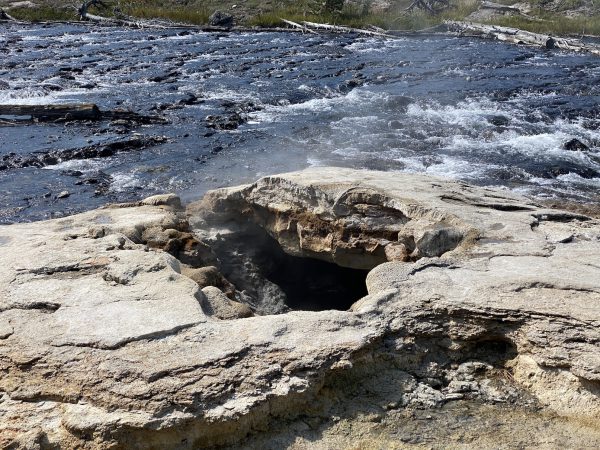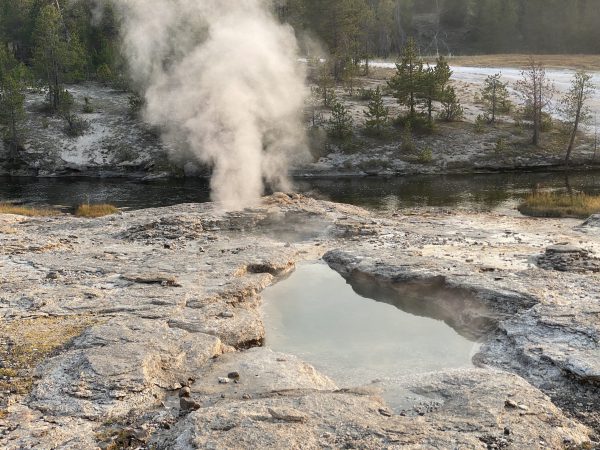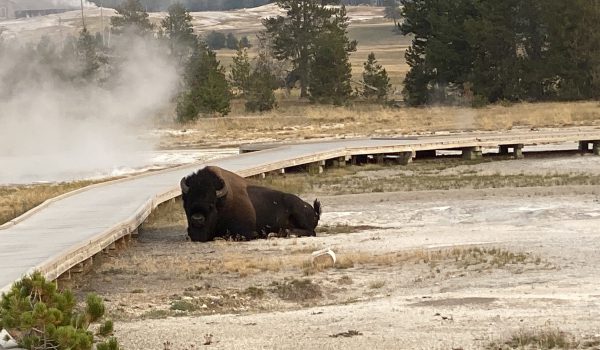Once again, got up while still dark to check on Fan & Mortar, and once again, they hadn't erupted. So sat myself down to watch and listen to Angle Vent chug away for an hour, until it was time move over to Grand.
It was another double interval, so may have gotten there early. But the second Turban eruption was a Delay Interval. The only good thing about it was that it meant that the eruption would be under less steamy and brighter conditions.
It only took two Turban eruption intervals before the start of another One Burst Grand Eruption. And the conditions were excellent, as even the smoke hadn't settled in yet.
After reconfiguring and having some breakfast, went back out to Fan & Mortar. Still nothing much happening. The big entertainment was about a dozen duck appeared down river, and made their way to where the North Chain runoff channel used to be. There they landed and then settled down to sleep. They were leaving as I was leaving, about 1-1/2 hours later.
Went over to Grand for another eruption, and probably arrived at the end of a Turban Delay Interval. This eruption had a long duration, and the next Turban eruption had no overflow from Grand. Grand finally erupted on what was probably the fourth Turban interval, and the streak of One Burst Eruptions continued.
From there, we considered going back to the cabin, but instead decided to return to Fan & Mortar and kill some time there. Tara Cross was the only other person there. We killed some time as an uninteresting cycle progressed out at Fan. But about twenty minutes into the activity, Fan's High vent suddenly seemed to pick up. So much so that we decided that everyone else spread around the basin (from Artemisia to Grotto to Geyser Hill and the Lodge) needed a "heads up" alert, just in case this resulted in an eruption.
A few minutes later we saw a splash from Main Vent. This is the first time I can remember anything like this happening, which also meant that I had no idea what could happen next.
We saw another splash as the activity from High Vent became strong and continuous. Gold Vent was also pouring out water and itself nearly continuous. High was acting and looking a lot like Vent Geyser as it starts. I started taking video, as the activity continued on for about three minutes. By this time High was erupting to about six or seven meters high.
Then the water in East Vent welled up and it was erupting to at least ten, if not fifteen meters high. This activity lasted (according to my video recording) about 22 seconds, when first Lower Mortar, then Main Vent, and finally Upper welled up and out and into full eruption. This activity started about nine minutes after the first radio alert.
The wind could have been a little better, as the walkway from the middle of the bridge to Spiteful got soaked. I got soaked, and the initial surges from Main are still quite warm.
At some point Spiteful stopped, and became calm. At one point after Fan & Mortar had ended, it had a brief eruption from the back vents, with the rightmost vent throwing water horizontally a couple of meters to the left beyond the rim.
Later in the day, I went out for the early night eruption of Grand, only to walk up on Sawmill starting as I passed Scalloped. Then as I got up to Sawmill, I saw the start of a Penta steam phase. The group was in a deep drain. There was a lot of noise from the Main Vent, and the bottom Right Vent was occasionally spraying water onto the walkway. This activity lasted about four minutes.
The last Grand of the day was another One Burst Eruption. Again, based on Turban durations and intervals and Grand's lack of overflow, I guess that it was a Two Turban Interval Delay. Also, the eruption only lasted a bit over nine minutes, and even with the bright light, I saw no indication of a second burst.




